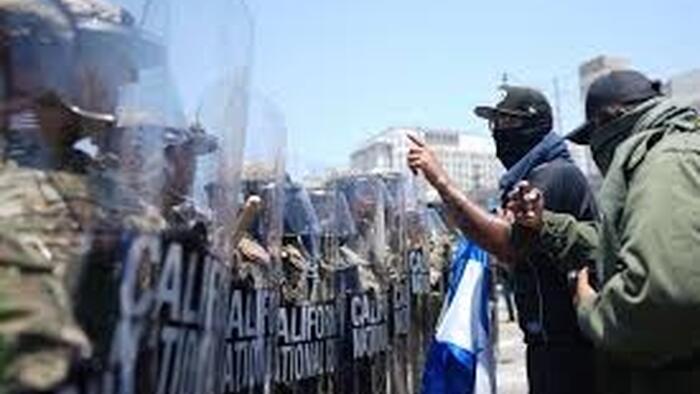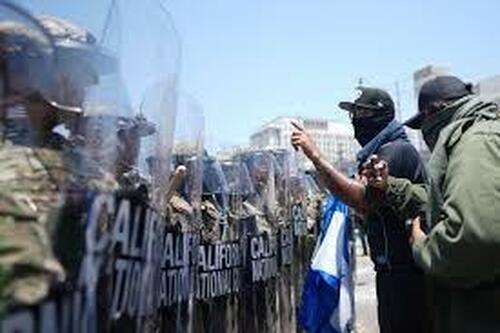


Gov. Gavin Newsom was in his element this week. After scenes of burning cars and attacks on ICE personnel, Newsom declared that this was all “an illegal act, an immoral act, an unconstitutional act.” No, he was not speaking of the attacks on law enforcement or property. He was referring to President Donald Trump’s call to deploy the National Guard to protect federal officers.
Newsom is planning to challenge the deployment as cities like Glendale are cancelling contracts to house detainees and reaffirming that local police will not assist the federal government.
Trump has the authority under Section 12406 of Title 10 of the U.S. Code to deploy the National Guard if the president is “unable with the regular forces to execute the laws of the United States.”
The Administration is saying that that is precisely what is unfolding in California, where mobs attack vehicles and trap federal personnel.
Most critics are challenging the deployment on policy grounds, arguing that it is an unnecessary escalation. However, even critics like Berkeley Law Dean Erwin have admitted that “Unfortunately, President Trump likely has the legal authority to do this.”
There is a fair debate over whether this is needed at this time, but the President is allowed to reach a different conclusion. Trump wants the violence to end now as opposed to escalating as it did in the Rodney King riots or the later riots after the George Floyd killings, causing billions in property damage and many deaths.
Courts will be asked to halt the order because it did not technically go through Newsom to formally call out the National Guard.
Section 12406 grants Trump the authority to call out the Guard and employs a mandatory term for governors, who “shall” issue the President’s order. In the memo, Trump also instructed federal officials “to coordinate with the Governors of the States and the National Guard Bureau.”
Newsom is clearly refusing to issue the orders or coordinate the deployment.
Even if such challenges are successful, Trump can clearly flood the zone with federal authority. Indeed, the obstruction could escalate the matter further, prompting Trump to consider using the Insurrection Act, which would allow troops to participate directly in civilian law enforcement.
In 1958, President Eisenhower used the Insurrection Act to deploy troops to Arkansas to enforce the Supreme Court’s orders ending racial segregation in schools.
The Trump Administration has already claimed that these riots “constitute a form of rebellion against the authority of the Government of the United States.” In support of such a claim, the Administration could cite many of the Democratic leaders now denouncing the claim.
After January 6th, liberal politicians and professors insisted that the riot was an “insurrection” and, in claiming that Trump and dozens of Republicans could be removed from ballots under the 14th Amendment.
Liberal professors insisted that Trump’s use of the word “fight” and questioning the results of an election did qualify as an insurrection. They argued that you merely need to show “an assemblage of people” who are “resisting law” and “using force or intimidation” for “a public purpose.” The involvement of inciteful language from politicians only reinforced these claims. Sound familiar?
Democrats are using this order to deflect from their own escalation of the tensions for months. From Minnesota Gov. Tim Walz calling ICE officers “Gestapo” to others calling them “fascists” and “Nazis,” Democratic leaders have been ignoring objections that they are fueling the violent and criminal responses. It did not matter. It was viewed as good politics.
While Newsom and figures like Sen. Cory Booker (D., N.J.) have called these “peaceful” protests, rocks, and Molotov cocktails have been thrown at police as vehicles were torched. Police had to use tear gas, “flash bang” grenades, and rubber bullets to quell these “peaceful” protesters.
There appears little interest in deescalation on either side. For the Trump Administration, images of rioters riding in celebration around burning cars with Mexican flags are only likely to reinforce the support of the majority of Americans for the enforcement of immigration laws.
For Democrats, they have gone “all in” on opposing ICE and these enforcement operations despite support from roughly 30 percent of the public.
Some democrats are now playing directly to the mob. A Los Angeles City Council member, Eunisses Hernandez, reportedly urged anti-law enforcement protesters to “escalate” their tactics against ICE officers: “They know how quickly we mobilize, that’s why they’re changing tactics. Because community defense works and our resistance has slowed them down before… and if they’re escalating their tactics then so are we. When they show up, we gotta show up even stronger.”
So, L.A. officials are maintaining the sanctuary status of the city, barring the cooperation of local police, and calling on citizens to escalate their resistance after a weekend of violent attacks. Others have posted the locations of ICE facilities to allow better tracking of operations while cities like Glendale are closing facilities.
In Washington, Jeffries has pledged to unmask the identities of individual ICE officers who have been covering their faces to protect themselves and their families from growing threats.
While Democrats have not succeeded in making a convincing political case for opposing immigration enforcement, they may be making a stronger case for federal deployment in increasingly hostile blue cities.
* * *
Jonathan Turley is the Shapiro Professor of Public Interest Law at George Washington University and the author of “The Indispensable Right: Free Speech in an Age of Rage.”

